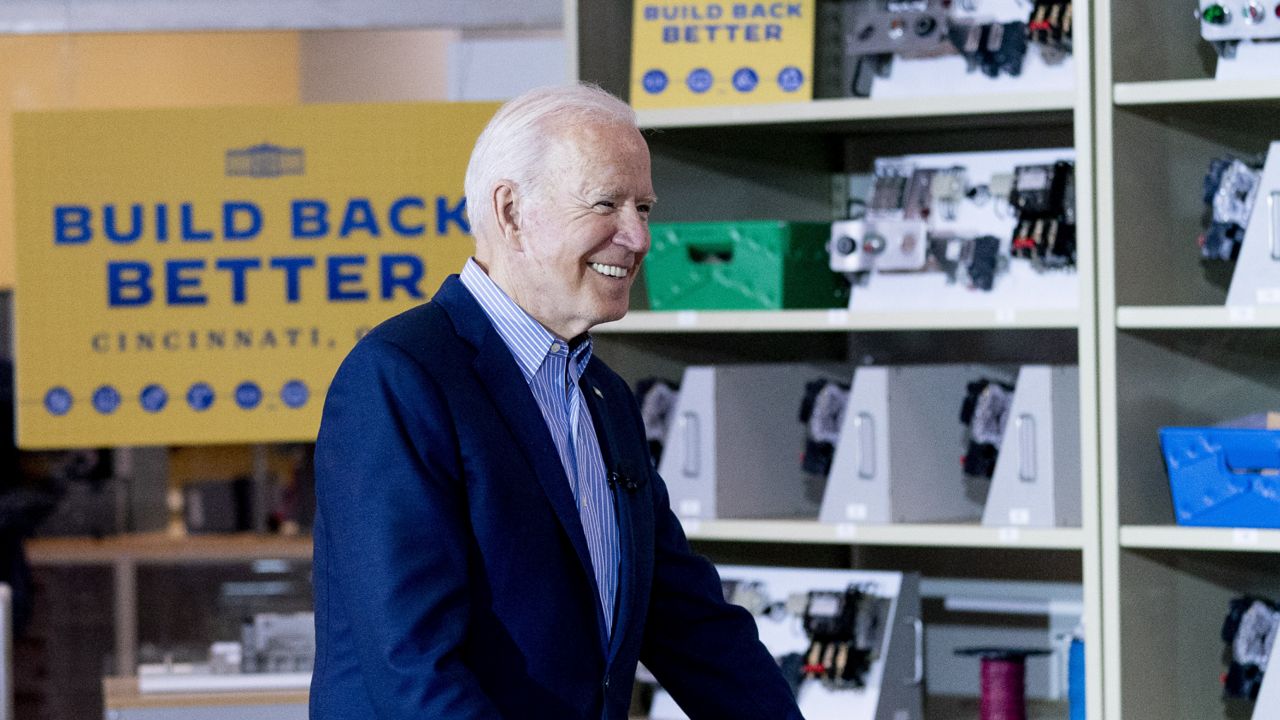Despite losing the state in the 2020 presidential election, President Joe Biden made his third trip to Ohio on Wednesday — the only state he lost that he’s visited multiple times — in an attempt to sell his economic plans directly to the people of the Buckeye State.
Biden first visited an International Brotherhood of Electrical Workers (IBEW) / National Electrical Contractors Association (NECA) electrical training center in Cincinnati, where he was given a hands-on tour of the electrical hanging station. Several signs bearing Biden’s “Build Back Better” slogan hung from the walls, and Biden touted the economic agenda he says will create good-paying union jobs, a top priority of the president dating back to his successful campaign.
Saying “unions are the best” when it comes to training employees, Biden repeated his oft-spoken refrain that they “built the middle class.”
The president’s visit brought him near the Brent Spence Bridge — an antiquated thoroughfare that connects Ohio and Kentucky, which even Senate Minority Leader Mitch McConnell, a frequent critic of Biden’s priorities, has called “dangerous and outdated.”
Both former Presidents Donald Trump and Barack Obama promised to replace the bridge, without success. Residents in Ohio and Kentucky told the New York Times they were optimistic for repairs to the bridge when McConnell and John Boehner, the former House Speaker who represented a district north of Cincinnati, were both in power in Congress, but action did not come.
"There is no bridge in the country that fits the criteria of an economically significant bridge better than the one that spans the Ohio River," Pete Metz, manager of transportation initiatives for Cincinnati USA Regional Chamber, said of the bridge to Spectrum News.
Mark Policinski, CEO of the Ohio-Kentucky-Indiana Regional Council of Governments (OKI), told Spectrum News that the bridge has been "functionally obsolete" since the 1980s.
"We are hoping the president will provide some clarity on how the new bill will address funding nationally significant, game-changing projects like the Brent Spence Bridge,” Policinski said.
The bridge, which was opened in 1963, carries $1 billion worth of freight across the bridge every day; more than $400 billion every year, according to Policinski.
But it is part of a corridor that is the second-largest trucking bottleneck in the country, according to the American Transportation Research Institute — second only to I-95 in Fort Lee, N.J., which leads into the George Washington Bridge into Manhattan.
"Nothing runs on time anymore if it crosses the Brent Spence Bridge," he added. "It is the poster child for the terrible state of our nation’s infrastructure. Never have U.S. roads and bridges been more vulnerable, making their funding all-the-more critical."
Biden is in the midst of pushing for the Bipartisan Infrastructure Framework, a nearly $1 trillion pact currently being negotiated in Congress that will provide funding for “hard infrastructure,” including roads and bridges like Brent Spence.
In response to a shouted question on whether he thinks a deal can be reached between Congress and the White House, Biden replied: “Yes we will.”
But back in Washington, Senate Republicans rejected an effort to begin debate on the big infrastructure deal, with supporters in both parties remaining hopeful of a better chance soon.
Democratic Majority Leader Chuck Schumer of New York had scheduled Wednesday’s procedural vote that he described as a step to ”get the ball rolling” as talks progress. But Republicans mounted a filibuster, saying the bipartisan group needed more time to wrap up the deal and review the details. They sought a delay until Monday.
According to the White House, the bipartisan infrastructure bill would help Ohio in a number of areas, including public transportation — 16% of trains and other transit vehicles in the state are past useful life — and broadband infrastructure — 6.2% of Ohioans live in areas where there is no broadband infrastructure that provides minimally acceptable speeds.
The White House calls the plan the "single largest dedicated bridge investment since the construction of the interstate highway system."
Ohio received a C- on its infrastructure report card from the American Society of Civil Engineers (ASCE), with 1,377 bridges and over 4,925 miles of highway in poor condition, per the White House.
Following his visit to the training center, the president headed off to participate in a CNN town hall, which will be moderated by Don Lemon.
The Associated Press contributed to this report.
